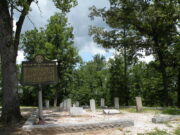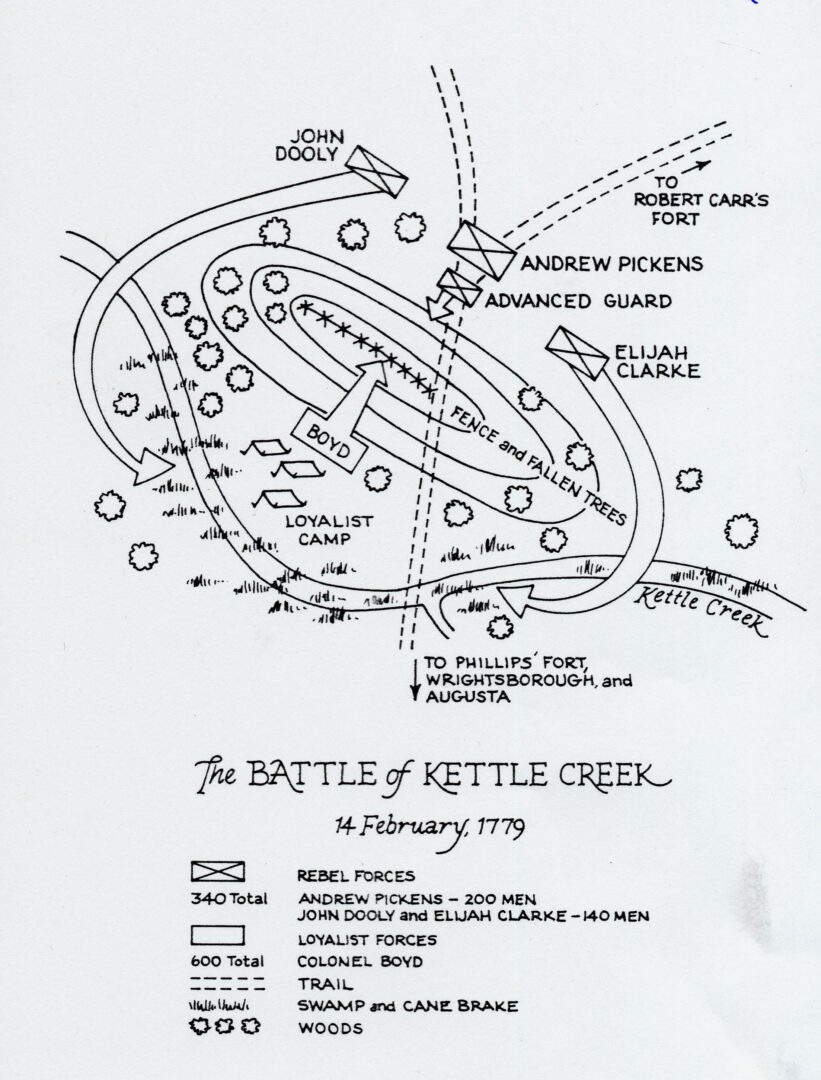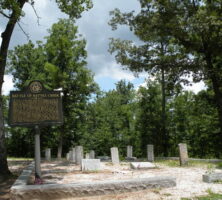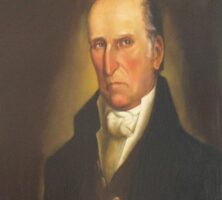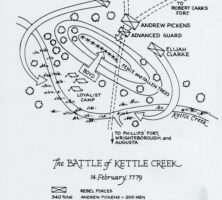Kettle Creek flows into the Little River near the Tyrone community in Wilkes County. It likely takes its name from a local fish trap, called a kittle.
During the American Revolution (1775-83) several incidents occurred along its banks. The South Carolina militia established a station there in 1776; an Indian attack on Robert McNabb’s Fort in November 1778 resulted in McNabb’s death; and in the last days of the Revolution, the rebel partisan and horse thief Josiah Dunn met his death in a skirmish nearby.
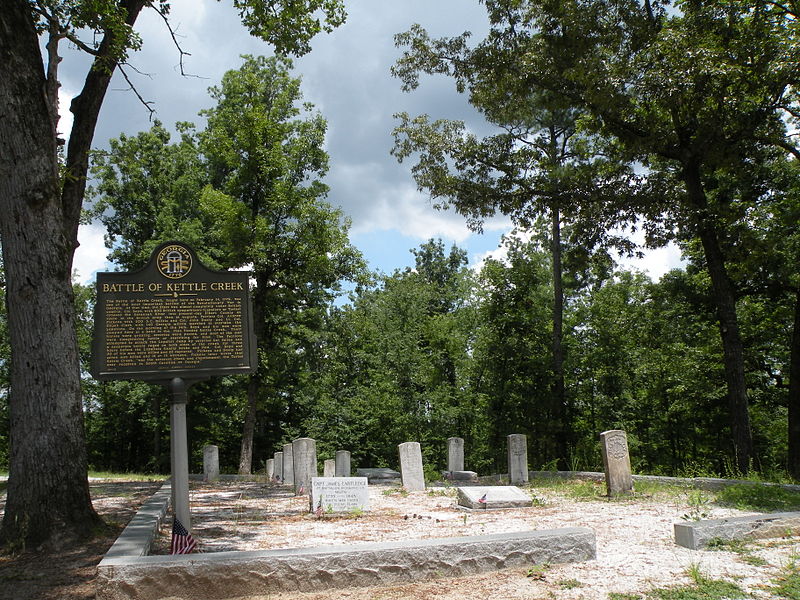
Photograph by Chris Crookston, Wikimedia
The most important event to occur at Kettle Creek, however, took place on Sunday, February 14, 1779. On that morning 600 American supporters of the British cause, popularly known as Loyalists or Tories, encamped atop a hill in a bend of the creek. They were following an established trail to the nearby Quaker settlement of Wrightsborough en route to Augusta. Aside from the defensive qualities of the position, the hill offered the new arrivals food in the form of cattle penned there.
The leader of this expedition, James Boyd, an Irishman from Raeburn Creek, South Carolina, had traveled to Georgia with a British invasion force from New York. He carried an open commission (as a colonel) to recruit southerners for the British military from settlements behind the rebel lines. Boyd left Savannah sometime after January 20, 1779, and reached Wrightsborough, deep within the Georgia backcountry, by the 24th, looking for guides to the South Carolina frontier. Within a week he established a camp near present-day Spartanburg, South Carolina. With 350 recruits he set out for Augusta on February 5. During their march south along the Indian frontier, Boyd and his followers were joined by 250 North Carolinians under the command of John Moore.
The Loyalists were ineffectively pursued by small groups of rebel militiamen. Boyd’s command captured Fort Independence and the outpost at Broad Mouth Creek in South Carolina, but they declined to attack the garrison of McGowan’s Blockhouse on the Cherokee Ford of the Savannah River. The Loyalists crossed the river further north at Vann’s Creek on February 11. The garrison of Cherokee Ford, with reinforcements, attacked Boyd’s men at the crossing but were repulsed. As Boyd and his men camped at Kettle Creek on February 14, he dispatched his prisoners to Augusta. He could not know that the British troops sent there to rendezvous with him had that morning begun a withdrawal toward Savannah.
At the same time 340 South Carolina and Georgia militiamen, under Colonel Andrew Pickens of South Carolina and Colonel John Dooly and Lieutenant Colonel Elijah Clarke of Georgia, were preparing to attack Boyd’s camp at Kettle Creek. They had been besieging Loyalist horsemen at Robert Carr’s Fort on nearby Beaverdam Creek when they abandoned their prey to intercept Boyd’s party. Four days of pursuit brought them almost to where they had started.
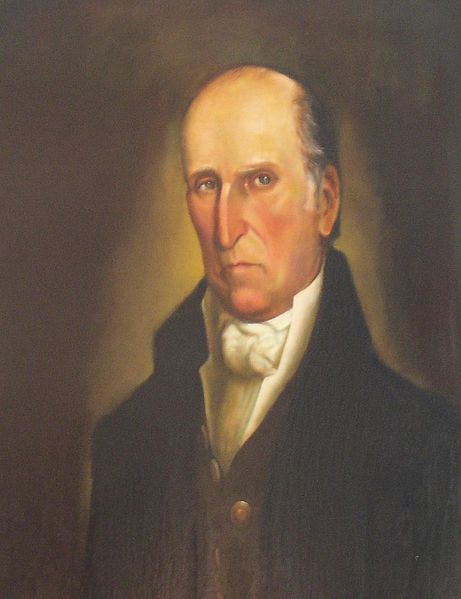
Photograph by Wikimedia
Pickens led his 200 men in a direct assault on the rocky hill on Kettle Creek, while Dooly and Clarke attacked the camp across the creek on the left and right respectively. Pickens’s advance guard disobeyed orders and fired on the Loyalist sentries, announcing the attack. Boyd led his men in ambushing Pickens’s troops while Dooly’s and Clarke’s men were entangled in the swamp.
Boyd fell mortally wounded, shot by a party of Georgia militiamen who had become lost and found themselves in the Loyalist camp. With their leader down, the Loyalists panicked and were driven across the creek. Boyd and nineteen of his men were killed, and twenty-two others were taken prisoner. Pickens and Dooly lost seven men, and fifteen were wounded. Counting the Loyalists who went home and later surrendered to local authorities, about 150 of Boyd’s men were eventually taken prisoner. They were held at Augusta and later at Ninety Six, South Carolina. Five of their number at Ninety Six and two others in North Carolina were eventually hanged.
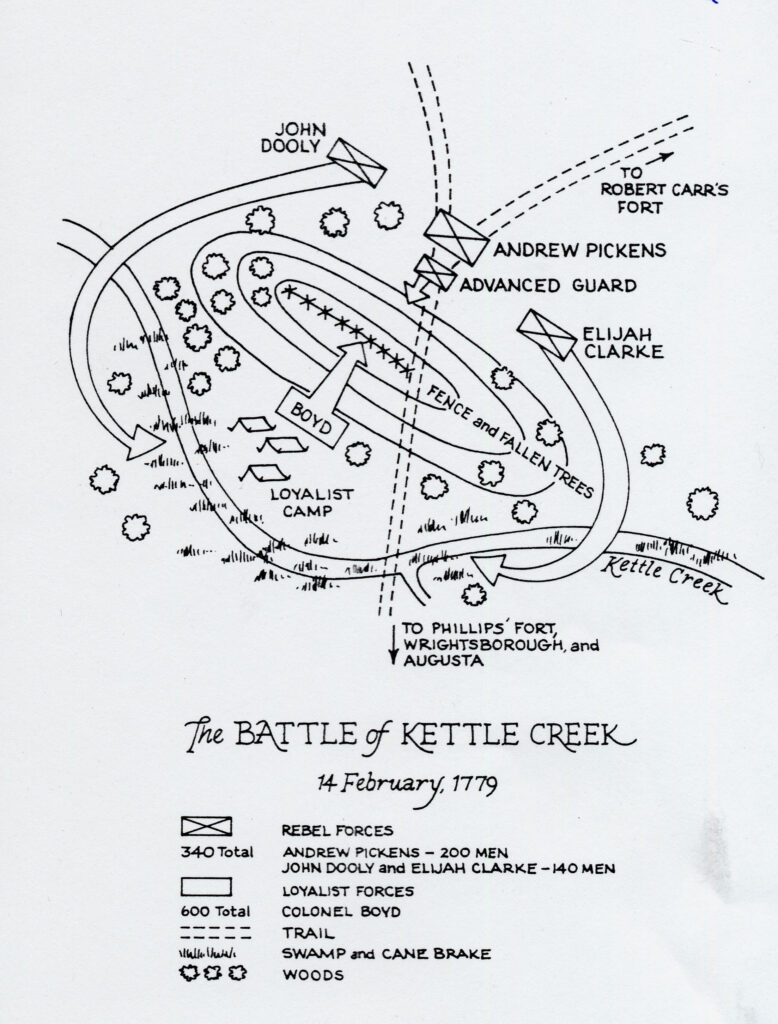
From Georgians in the Revolution: At Kettle Creek and Burke County, by R. S. Davis Jr.
Two hundred and seventy of Boyd’s command escaped the Battle of Kettle Creek and safely reached the British army. They were formed into the North Carolina Royal Volunteers under John Moore and the South Carolina Royal Volunteers (later the second battalion of the South Carolina Royalists Regiment). Both units virtually disappeared by the summer of 1779 because of desertions and transfers.
The Battle of Kettle Creek provided the rebel cause with a victory, however small, in the midst of a string of much larger defeats. The British had expected thousands of loyal southerners to rally to their flag and restore the whole South to the king. However, Boyd proved only able to assemble 600 men, some of whom were criminals in flight. Other men who traveled with him were allegedly coerced into joining under threats to their lives and property.
After Kettle Creek, British leaders should have realized that practical Loyalist military support in the South, if it ever existed, had disappeared. Campaigns to find a great Loyalist army in the South continued, however, through the defeats at King’s Mountain, Hammond’s Store, Ramsour’s Mill, and even Yorktown. On the local level, many of the southerners who shared Boyd’s dream to return the South to the king’s cause learned the futility of their hopes on impromptu gallows at the hands of their rebel neighbors.
Today a county park preserves the Kettle Creek battlefield. Rechanneling in the early 1920s turned the original cane-choked creek into a dry ditch. Monuments were erected on the hill by the federal government in 1930 and the state of Georgia in 1979. The Kettle Creek Chapter of the Daughters of the American Revolution maintains a cemetery in the park for the remains of Revolutionary War veterans. The Georgia Compatriots of the Sons of the American Revolution supports the preservation of the site.


